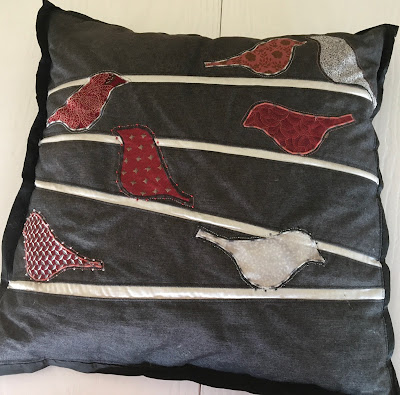While we are probably using our stash a bit more cautiously at the moment until it gets easier to replace fabric and threads, as well as trying to reduce our consumption of resources generally, we have been looking around at home for things we can re-use or repurpose in our embroidery work.
Once we started delving into the subject, we found that there is actually a huge range of items that can be pressed into use, and so there will be more on the subject coming up in a while.
Part 1: Fabrics
· Don’t discard the selvedges cut off fabrics.
Here they have been sewn together to make into a useful sewing organiser with pockets. Plastic tablecloth fabric has been used to make the inside pockets, which are transparent, so the contents are easily visible.
 |
While we may no longer want to hang some of our cross stitch pictures or tapestries, we probably still treasure them. A way to preserve them is to take them out of their frames and re-make them into book covers, pages within keepsake books or needle cases, for example.
 |
Tapestries can be transformed into various styles of bag, from pouches and clutches to really strong shopping bags. Depending on size, they can be combined with additional upholstery fabric (see below) and further embellishments.
Fay Maxwell also updates old tapestries into gorgeous tiny cushions by adding extra stitching, using wools, ribbons, and cords.
· Embroideries which are no longer pristine
If you have a family embroidery or have been given someone‘s old work that has become grubby, you can try washing them carefully. If they still don't clean up, however, and can’t be restored to an acceptable state, then try painting them with gesso. Once the gesso is dry, colour them with e.g. acrylic inks, which have been applied in a blob and then scattered by blowing through a straw.
· Jeans
Jeans that have been discarded (see last month’s article on ‘Upcycling your clothes’ for ideas on extending their life) make a good firm base for all kinds of stitching.
Here they have been cut into strips, and made into a book cover as a gift, with a pocket added on the front for pens.
Jeans are ideal to cut up for ‘boro’ stitching, a traditional Japanese form of mending/patching that extended the life of working garments, and is now very much in line with current ideas about ‘visible mending’
Men’s ties
These are often made out of some super fabrics, which are perfect for appliqué techniques - as shown by the birds on this cushion.
· Lace or old net curtaining
Add to vintage and delicate pieces of work
or
use as a resist:
If you pin it to a piece of fabric such as an old sheet you can pass moulding paste though it and then pull it off to reveal the pattern. Lace can also be used in the same way. Paint both the lace and the background fabric when they are completely dry.
· Bandages
If the contents of your first aid box have gone out of date, don't bin the bandages and non-woven dressings, but use them in place of scrim - they can be dyed and provide a good, textured surface.
· Old Sheets
A really valuable resource! They make great backing fabrics in place of purchased commercial stabilisers, and they take dye or paint very readily for use in many projects.
· Old tablecloths and linens
Those which have existing embroidery add an extra dimension to projects. Use the whole piece as the basis for new work, or if it's too worn, cut out elements to add to your piece.
Anne Kelly and Cas Holmes, among other textile artists, incorporate these old linens into their work, as demonstrated by this piece created at Anne Kelly's workshop last year.
If you have any fabric that sits in your stash year in year out and doesn't inspire you .... why not change its colour?
The soft blue toned fabric on the left had been sitting around for a long time. Needing green fabrics, Gill changed its colour with a tiny amount of acrylic ink in water (in a recycled food pot). Soak the fabric and let it dry. This is a quick and easy technique, but you could alternatively use thinned down acrylic paint. Worth experimenting, but not all types of paint are colourfast.
Hessian
You may be lucky enough to have old hessian sacks in the shed, for instance, which can be repurposed, although hessian is also very cheap to buy new. It looks good alongside vintage fabrics, such as faded cottons or with tonally different pale coloured fabrics. It has been used here to create the outer cover of a concertina book, inspired by Helen Hallows' recent 'Draw to Stitch' workshop:
We hope these ideas have given you food for thought. Part 2 will look at a range of items that can be used as ‘threads’, embellishments or dyestuffs. In the meantime, if this sparks memories of any items you have found and used in your work, please email: leamingtondistrictitrep@embroiderersguild.co.uk and we will include them next time.













Very inspirational blog - must take another look at my stash.
ReplyDelete